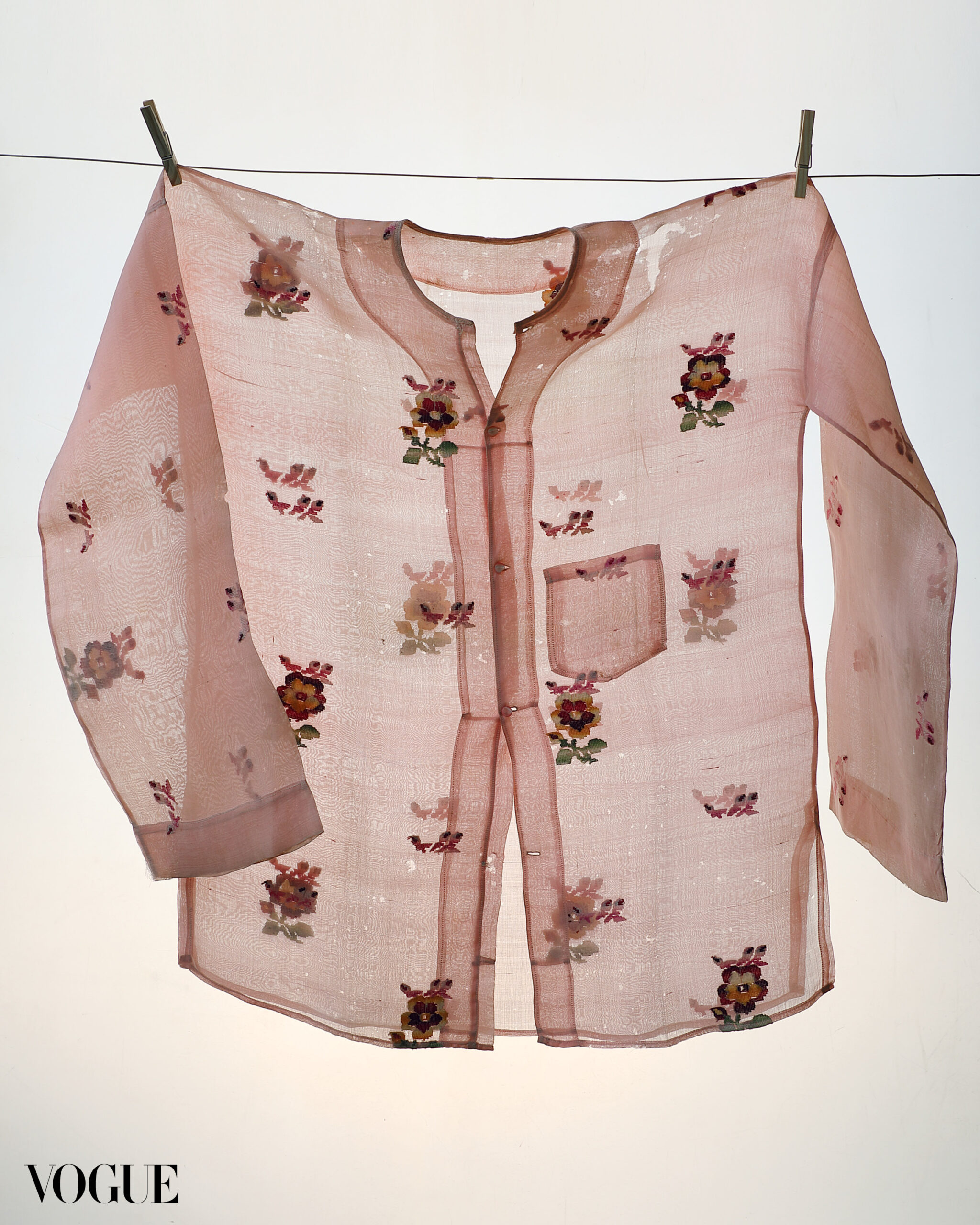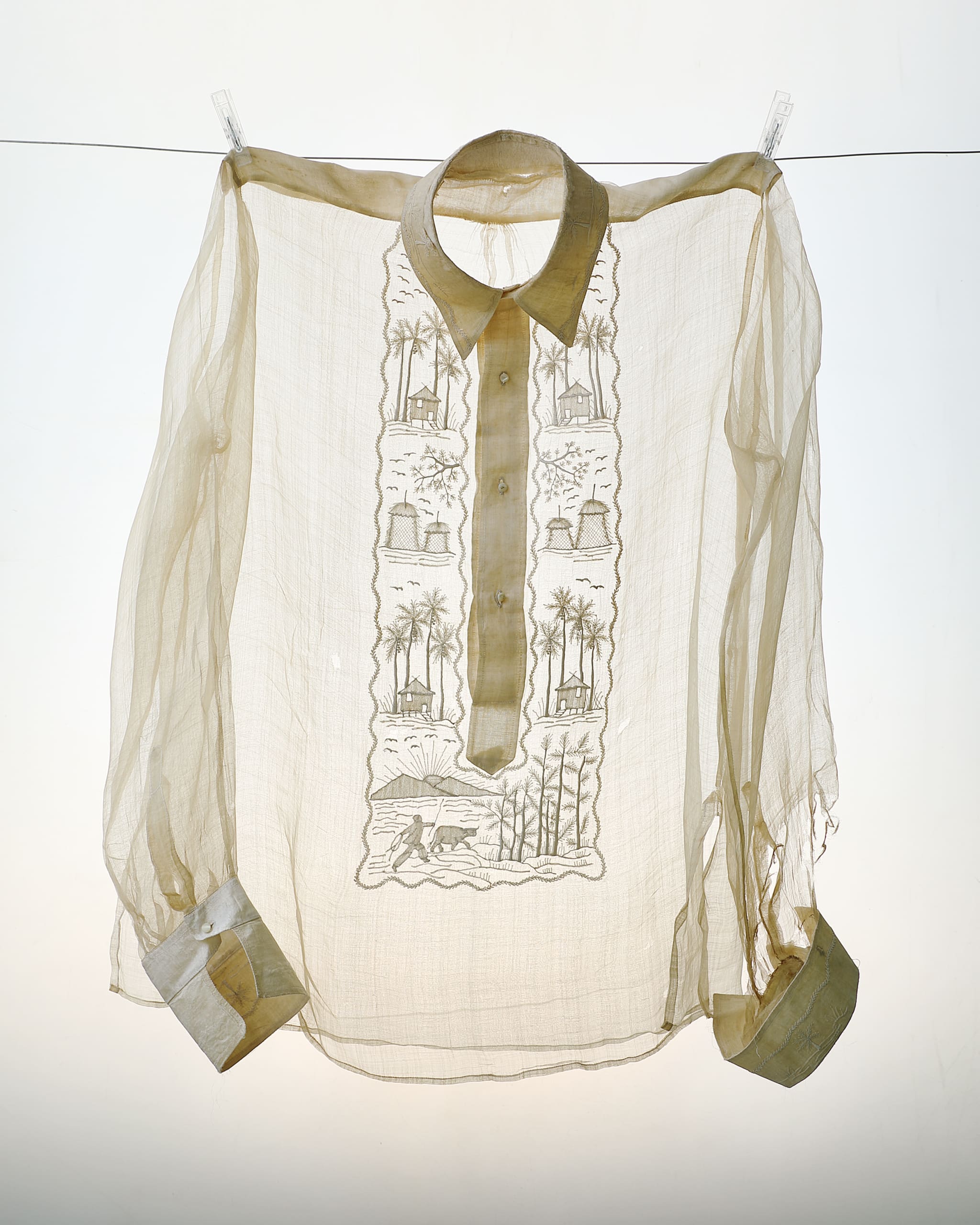Photo by Jo-Ann Bitagcol
In tracing the roots of the Philippine national dress, Marian Pastor Roces reiterates culture’s wobbly relationship with indigenous materials.
The national dress began with entirely foreign material.
But such is culture. It takes stuff from everywhere and proceeds to own these borrowings and pickings from here and there.
The pineapple—a bromeliad, which traveled from a dark green, antediluvian space between Brazil, Argentina, and Paraguay—arrived in Las Islas Filipinas no earlier than four centuries ago, likely somewhat later. More likely: it was source of Vitamin C on the long galleon voyages from Acapulco. Bromelia ananas was a valued transpacific passenger, part of the merchant’s and adventurer’s survival kit.
Perhaps 200 years ago, a woman—had to be a woman—saw past the curious, many-eyed fruit and wondered, finally tried, then finally succeeded in stripping fiber from the leaves with prickly edges. Extracting the nearly gossamer filament and imagining it becoming cloth, she, too, became someone else: the mother of local inventors in the colonized islands.
Whoever she was, or whoever they were, thoughts about their audacity excites. Seems some ancestors were attracted to impossible challenges and sometimes leaped to surprising ideas and parts unknown.
As today, piña cloth takes some doing. It used to be woven under mosquito netting. So fragile is the strand, a breeze could snap it. Each thread is a sequence of miniature knots to make a length to weave into a viable fabric. The seductive fragility is inevitably mentioned by clothing and textile historians. But much else is unremarked, or entirely unnoticed—especially some fairly hard contradictions veiled in delicacy.
First, though, the weaving of cloth and nation. Before venturing into the shadows.
Nation according to the barò & baróng
Piña—alternatively and simultaneously cloth and clothing—became inextricable from the fashion concept of baróng Tagalog, male signifier, and barò, the female equivalent. Sure, these garments are also fashioned of indigenous ramie, imported linen and cotton, and from fibers of the plant, abaká, always mistaken for its cousin bananas, to make the loosely woven sinamáy. However, it is in piña that the idealized character of the costume is set: transparency, principally; and indeed, a diaphanousness wrought via delicate cut-openwork (calado) and white-thread embroidery.
The piña barò and baróng do not appear to have an indigenous precedent. No prior see-through garment seems connected to its form at the time of its invention, except, speculatively, as local versions of the sometimes-translucent South Asian kurta and the light Chinese garment called in Spanish the camisa de chino.
The point to be made is not so much about an upper garment influenced by this or that, but that it emerged sui generis enough in the mid colonial period. The cloth is about inventiveness in the face of change, and not quite about indigenous changelessness.
Its enduring vogue among all of the Philippines’ de facto and would-be rulers through more than a century, as a premier sign of nationalism, invites scrutiny. Or, at least, an arched eyebrow.
That it was invented in the prelude centuries to the Philippine birth of nation at the end of the 19th, suggests what kind of symbol it is. During that Eurocentric time, piña barò and baróng spoke well as proof of civilized status, however residually—and subtly—attached to nakedness. But proof, nonetheless, of capacity to self-govern, and moreover, proof of educated ruling classes emerged from the jungle.
“That the unknowable woman who started weaving pineapple leaf fiber was most likely a bare-breasted and probably tattooed resident of the Visayan islands, conjured an extreme fabric that hides nothing.”
Distance from the jungle
These clothes say the same thing now, especially in continuing contrast to indigenous people.
The piña barò and baróng mirrors exactly the same modernity as the idea of nation: costume and nation both mark a radical break with the past. Nations, of course, are a modern form of community, no older than the 18th century. And in its 18th century origins in Latin America, a nation was a community of mestizos.
Which excludes the “native.” Or only includes them as “them”—to be consumed by tourist eyes intrigued by National Geographic or bedazzled in spectacles and pageants.
Not the nationalist person in the barò or baróng. This person, called the Filipino since 1898, the citizen possessed of modernity, continues to construct, perhaps reinvent the nation. Because barò or baróng are as much inventions as the nation these symbolize, energetic refigurations of both clothing and nation—from TernoCon to Charter Change, from silkscreened pintados tattoos on the “Queen of fabrics” to institutionalized people power—rev up the adrenaline of Filipinos who appropriate (yes this is the right term) leadership roles.
Where “Filipino” in the entire Spanish colonial period meant a person of Spanish descent born in the islands, this modern Filipino is always gently addled, thinking the “tribal” as “roots” but thinking, too, that this “them” is not “I.”
The barò or baróng clad denizens of the Republic, designers and Congressmen both, also feel quite free to extract fashion ideas from this roots-suffused other, in the name of, yes, nationalism. Some might say enlightened nationalism. “Tribal” patterns materialize on that virtual skin the barò or baróng provide.
Shadows & paradox
The paradoxes are subtle and hard to detect, but are actually in plain sight—apropos enough of clothing that reveals while not revealing.
This bears reiterating: culture’s relationship with indigenous materials is wobbly. Sometimes, or indeed often, indigeneity means foreign stuff indigenized; exotica reconstituted to become local culture.
Also: that the unknowable woman who started weaving pineapple leaf fiber was most likely a bare-breasted and probably tattooed resident of the Visayan islands, conjured an extreme fabric that hides nothing. Layering is in truth a bedeviling fashion maneuver in the case of the national dress.
Or furthermore that this long-ago woman made a fabric that will be baptized with the all-important word “national” when, as things transpired, Asia’s first republic materialized in the colonial outpost and needed symbolic raiment. This national costume, as it began to be called in the early 20th century, will be worn with both pride and chemise by mestizos Filipinos—who were by then culturally distant from the woman who invented the cloth in the first place.
The shadows cast by the transparent barò or baróng also obscure from public view the continuing inventiveness of the erstwhile tribal. In time (given quicker updating of scholarship in the public domain), that indigenous person will be acknowledged, not as embodiments of roots, but what they are in truth: cultural and linguistic kin to most citizens, changing and creating change as everyone else is.

Signaling modernity late in the day
In the meanwhile, the paradoxical role of the piña barò and baróng to symbolize departure from tribal nakedness with its cultivated sheerness is an accurate reflection of the state of the nation. It is an elusive and somewhat anxious symbol, signaling 19th-century modernity experimenting with 21st-century possibilities of breaking with the past that nevertheless seems to require modern loving.
But doubtless, the time will come when the idea of indigeneity as synonymous with the past will yield to complex ideas of indigeneity, and hence, nationalism. By that time, the nation will have a national dress, not a costume, that is inflected by a shared capacity to fly to a place of true inclusivity.
